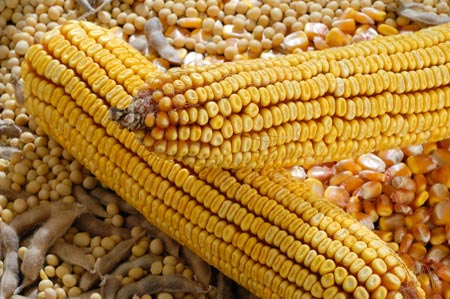 (Businessweek) – Japan, the largest corn buyer, will probably boost U.S. imports after cutting its reliance on American grain to the lowest-ever level, as Chicago futures entered a bear market, industry officials said.
(Businessweek) – Japan, the largest corn buyer, will probably boost U.S. imports after cutting its reliance on American grain to the lowest-ever level, as Chicago futures entered a bear market, industry officials said.
Purchases for the three months through September may jump 41 percent to 2.6 million metric tons from this quarter, said Nobuyuki Chino, president of Continental Rice Corp. in Tokyo. U.S. prices are becoming competitive against South American and European supply, leading to a recovery in demand, Mitsuyoshi Haruno, executive director for Japan Feed Trade Association, said in an interview in Tokyo.
Purchases from the U.S., the biggest exporter, slumped 25 percent to 1.85 million tons for shipment this quarter, representing 50 percent of Japan’s total imports, said Chino, who has traded grains for more than three decades. Higher prices last quarter, coupled with the yen’s 8.6 percent drop against the dollar, boosted costs for feed mills, spurring them to seek cheaper alternatives from Brazil, Argentina and Ukraine.
“A sharp retreat in Chicago prices is likely to revive demand from Japanese buyers for U.S. supplies,” said Tetsuo Hamamoto, director for the Tokyo office of the U.S. Grains Council. “Compared with other exporters, the U.S. has an advantage in terms of the reliability of supply, and it can offer crops of better quality to customers.”
Japan raised spending on corn reserves by 18 percent this fiscal year after some shipments from South America and Europe were delayed, forcing feed mills to draw on stockpiles, the Agriculture Ministry said in January.
Bear Market
Corn plunged the most in 24 years and entered a bear market on April 1 as bigger-than-expected U.S. stockpiles and increased planting signal ample supplies. Farmers will plant 97.282 million acres this year, the most since 1936, after last year’s drought cut U.S. output by 13 percent and boosted futures to a record, the U.S. Department of Agriculture said on March 28.
Japan needs 2.7 million tons of corn next quarter for livestock feed and 1 million tons for food, sweeteners and other purposes, Chino said in an interview. Buyers may source about 70 percent of the total from the U.S., he said.
Japan bought half of its requirement for this quarter from the U.S., Chino said. The country also bought 700,000 tons from Brazil, 500,000 tons from Argentina, 100,000 tons from South Africa, and the rest mainly from the Black Sea region, he said.
In the first two months of this year, U.S. corn represented 410,425 tons, or only 26 percent of Japan’s total imports of the grain for feed, data from the Finance Ministry showed. That’s the lowest-ever ratio, said Hamamoto at the U.S. Grains Council. Brazil was the largest supplier to Japan with 1.1 million tons.
Cheaper Alternatives
Japan cut corn imports by 2.5 percent to 14.9 million tons last year, the lowest level since 1986, as local feed mills sought wheat and so-called DDGS as cheaper alternatives. U.S. exports of dried distillers’ grains with soluble, a byproduct from ethanol processing, jumped 35 percent to 452,801 tons last year as the high-nutrient material also helps Japanese feed makers cut consumption of soybean meal, a source of protein for livestock, according to Hamamoto.
Japan’s imports of feed wheat may stop expanding this year, as corn has become more affordable than wheat to Japanese buyers, Chino said. Wheat in Chicago traded at $6.9575 a bushel at 3:49 p.m. in Tokyo, while corn traded at $6.41 a bushel.
The Agriculture Ministry reduced the ceiling on feed-wheat imports by 12 percent to 1.07 million tons for this fiscal year from a year earlier. Japan’s imports of feed wheat more than doubled to 900,000 tons in the year ended March 31, the highest level in 15 years, according to the ministry.
Corn fell more than 20 percent since last year’s closing high of $8.3875 on Aug. 21, meeting the definition used by some investors to identify a bear market. Prices rallied to an intraday record of $8.49 on Aug. 10 as the worst U.S. drought since the 1930s scorched crops. Since then, farmers in South America have boosted output and Midwest growers are planning to expand production.




